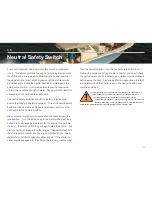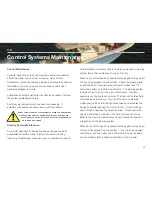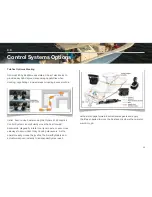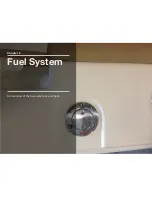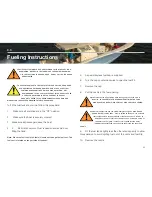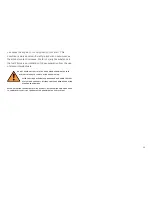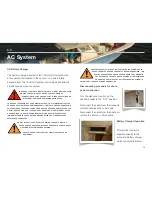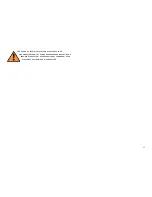
Periodically inspect all primer bulbs, connections, clamps and
hoses for leakage and damage or deterioration. Replace as
necessary. Spray the valves, tank fuel gauge sender and ground
connections with a metal protector.
Frequently inspect and lubricate the fuel fill cap O-ring seal with
petroleum jelly or silicone grease. The O-ring seal prevents water
from entering the fuel system through the fuel fill cap and it
should be immediately replaced if there is any sign of damage or
deterioration.
The fuel vent screen should be clear and free from corrosion and
salt buildup. The screen will prevent insects and other foreign
matter from contaminating the fuel and fuel system. Fuel vent
should be replaced if the vent or screen are damaged or badly
corroded. Fuel vent screens that are clogged will prevent the
fuel tank from venting properly and make filling the fuel tank
di
ffi
cult or cause fuel supply problems to the engine.
Contaminated fuel may cause serious damage to your engines.
The filters must be checked for water and other contamination
frequently. The filter elements must be changed at least once a
season or more frequently depending on the type of engines and
the quality of the fuel. Please refer to the engine or fuel filter
manufacturer’s instructions for information on servicing and
replacing the fuel filter elements.
The age of gasoline can e
ff
ect engine performance. Chemical
changes occur as the gasoline ages that can cause deposits and
varnish in the fuel system as well as reduce the octane rating of
the fuel. Severely degraded fuel can damage the engine and
boat fuel tank and lines. Therefore, if your boat is not being run
enough to require at least one full tank of fresh fuel a month, a
fuel stabilizer should be added to the gasoline to protect the fuel
from degradation. Your dealer or the engine manufacturer can
provide additional information on fuel degradation and fuel
stabilizers recommended for your engine.
Avoid using fuels with alcohol additives. Gasoline that is an
alcohol blend will absorb moisture from the air which can reach
such concentrations that “phase separation” can occur whereby
the water and alcohol mixture becomes heavy enough to settle
out of the gasoline to the bottom of the tank. Since the fuel pick
up tube is very near the bottom of the tank, phase separation
4.4
Fuel System Maintenance
37
Summary of Contents for 320 LXF
Page 1: ...320 LXF Scout Boats OWNER MANUAL ...
Page 2: ...Chapter 1 Owner s Information Warranty Certification and Boat Information ...
Page 11: ...Chapter 2 Propulsion A guide to your boat s propulsion system ...
Page 32: ...Chapter 4 Fuel System An overview of the fuel system of your boat ...
Page 40: ...Chapter 5 Electrical System An overview of the electrical system of your boat ...
Page 54: ...Chapter 6 Fresh Water System An overview of the fresh water system of your boat ...
Page 59: ...Chapter 7 Raw Water System An overview of the raw water system of your boat ...
Page 65: ...Chapter 8 Drainage System An overview of the drainage system of your boat ...
Page 70: ...Chapter 9 Ventilation System An overview of the ventilation system of your boat ...
Page 73: ...Chapter 10 Exterior Equipment An overview of the exterior equipment on your boat ...
Page 83: ...Chapter 11 Interior Equipment An overview of the interior equipment on your boat ...
Page 88: ...Chapter 12 Safety Equipment An overview of the safety equipment on your boat ...
Page 99: ...Chapter 13 Operation A general guide to operating your boat ...
Page 124: ...Chapter 14 Routine Maintenance A guide to keeping your boat running in good condition ...
Page 147: ...Chapter 16 Appendix Reference documents logs and schematics for your boat ...
Page 154: ...153 ...
Page 155: ...154 ...
Page 156: ...155 ...
Page 157: ...156 ...
Page 159: ...158 ...
Page 160: ...159 ...
Page 162: ...161 ...

